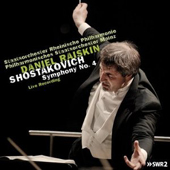
DEFINITIVE RECORDINGS

It's good recordings like this one that provide the proof and backup needed to support a positive answer to the age old question: "Do we really need another recording of
this piece?" Unlike its more famous sibling, the Symphony No. 5, which is well represented in the catalogues with close to 100 recordings, the
Symphony No. 4 in C minor, Op. 43 stands knee-high to it with about 30% as many recordings. Still, a formidable achievement for a misunderstood
and underrated work which didn't see the light of day until 25 years after its conception. And even though some of these existing recordings are front runners
in their own right (Barshai, Gergiev, Haitink), this new 'live' recording under the baton of conductor Daniel Raiskin brings home the fact that
this Symphony deserves way more attention than it garners. It contains all the earmarks and some of the trademarks of the Shostakovich to come, combined
with some fierce writing, Mahlerian irony, and fathomless emotional depths.
Under Raiskin's guidance and clearcut interpretation, the combined forces of the Mainz Philharmonic Orchestra and the
Rheinische Philharmonie State Orchestra justify each and every note of this opulent score, and emphasize the brilliance of its orchestration.
The moments of fierce determination, bone chilling funereal quiet passages, sarcastic fanfares, mechanistic military force, and that ever so mysterious and
enigmatic ending, are all reproduced with a level of conviction and purpose rarely witnessed these days. For example, the massive four-part fugue for the string
sections that starts at the 15:50 mark of the first movement may not be as fast as the Barshai version, but the string players dig so hard with their bows I'm surprised
some of the instruments didn't catch fire. And within two minutes of this frenzied activity the heavy military drums and full orchestra come in with such force that you
feel the urge to run for cover. Add to all this the nervous energy of a live recording and audiophile quality sound, and you have the recipe for an amazing performance of a stupendous symphony.
Within the booklet notes, conductor Daniel Raiskin alludes to the fact that he would have liked to have been part of the audience at the 1961 première of this
work and feel the electricity in the air. I understand exactly what he means as I would have liked to have been part of the audience during the performance of this recording,
and be a witness to the same degree of awe and adrenaline rush this level of music-making generates.
Jean-Yves Duperron - December 2011